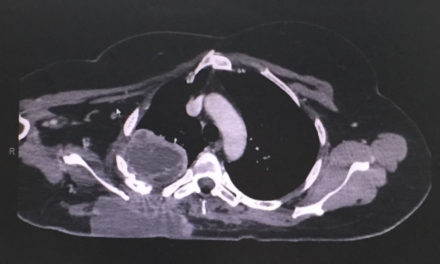Poison Control: The Hydroxocobalamin Shortage
Cyanide and the toxicities associated with its exposure have a long and rather famous history. Dating back to World War I, Napoleon was noted to have used cyanide in chemical warfare. The Nazis in Germany also utilized cyanide in the gas chambers during the Holocaust. Another infamous event was the Jamestown suicides where 913 people died from drinking juice poisoned with cyanide. [1]
Despite the ever-increasing education and detection monitors available, cyanide toxicity—whether from house fires, industrial work or medicinal exposure—continues to be seen on occasion in the emergency department. With the introduction and production of the most common modality of treatment, hydroxocobalamin (CyanoKit), providers are able to quickly and easily treat confirmed and suspected cases of cyanide toxicity. However, a national shortage of hydroxocobalamin occurred in late 2018, when Meridian Medical Technologies experienced major delays in production coupled with an increasing demand for the product.2 This drug shortage, as many do, left us to evaluate what alternative options we as emergency medicine providers have to treat a patient who presents with cyanide toxicity.
Initial management of this toxicity includes a primary survey to assess the patient’s airway, breathing and circulation, and to ventilate the patient with 100% oxygen. While the patient is being stabilized, if there is suspicion of cyanide toxicity, (including hemodynamic abnormalities, headache, paired with history of possible exposure), providers should begin thinking about specific treatment for cyanide. Suspicion can be further confirmed by laboratory findings of metabolic acidosis, elevated lactic acid and anion gap, elevated levels of venous oxygen on blood gas analysis, and a cyanide level (if readily available at your institution). Cyanide levels greater than 2.5 ug/mL have led to respiratory depression and coma while levels greater than 3 ug/mL are associated with mortality. With a confirmed or suspected case of cyanide toxicity, prompt antidotal therapy is imperative. [1,3]
While hydroxocobalamin has been the treatment of choice for cyanide toxicity since its approval in 2006 by the FDA, it was not the original antidote used. [1] The previous method of treatment included amyl nitrite, sodium nitrite and sodium thiosulfate. Although these agents may seem outdated, a resurgence of their use may occur in the face of the hydroxocobalamin drug shortage. Amyl nitrite and sodium nitrite work against cyanide toxicity by oxidizing hemoglobin to methemoglobin. Methemoglobin preferentially binds to cyanide releasing cytochrome a3, a component of the cytochrome c oxidase complex, to restore aerobic respiration. [1] Amyl nitrite is a highly volatile substance that is packaged in ampules to be broken and administered via inhalation. The utility of amyl nitrite has been questioned in the literature due to the low percentage of methemoglobin produced, however, it may be an appropriate temporizing option to utilize while sodium nitrite is being prepared. [1,3]
Sodium nitrite is available as 3% solution given intravenously as a 300 mg dose over 2-4 minutes (adult dose). [3] Hypotension is a known side effect of nitrite administration and the rate of infusion should be slowed if it occurs. Methemoglobin levels should be measured 30 minutes post-dose with a target level between 20-30%. [1,3] Finally, sodium nitrite administration should always be followed with a dose of sodium thiosulfate. Sodium thiosulfate donates a sulfur group to enhance the catalyzation of cyanide to thiocyanate by the enzyme rhodanese. Thiocyanate is less toxic than cyanide and is renally eliminated. Sodium thiosulfate is available as a 25% solution to be given intravenously at a dose of 12.5 g. [3] Sodium nitrite and sodium thiosulfate, despite being used to treat cyanide toxicity, were not officially approved for this indication by the FDA until Nithiodote was approved in 2011. [4] Nithiodote contains one 300 mg/10 mL vial of sodium nitrite and one 12.5 g/50 mL vial of sodium thiosulfate, making the product convenient for its indicated use in acute cyanide toxicity.
Ultimately, patients who receive an antidote for cyanide toxicity should be admitted for observation and signs of improvement. [3] Though the manufacturers of hydroxocobalamin now report an adequate supply of the medication, hospital pharmacies that experience a limited supply of hydroxocobalamin should evaluate their inventory for the alternative antidotes in preparation for potential cyanide toxicities. ■
References
- Howland M. Nitrites (Amyl and Sodium) and Sodium Thiosulfate. In: Nelson LS, Howland M, Lewin NA, Smith SW, Goldfrank LR, Hoffman RS. eds. Goldfrank’s Toxicologic Emergencies, 11e New York, NY: McGraw-Hill; Accessed June 21, 2019.
- Meridian Medical Therapeutics (personal communication). July 25, Aug. 8, Sept. 11, Nov. 8, Dec. 10, 2018; Feb. 12, April 17, May 29, 2019.
- Micromedex® Healthcare Series [Internet database]. Greenwood Village, Colo: Thomson Reuters (Healthcare) Inc. Updated periodically.
- National Library of Medicine (U.S.). (Oct. 2018). DailyMed. Nithiodote. Bethesda, MD: U.S. National Library of Medicine, National Institutes of Health, Health & Human Services.


 This article originally appeared in EMpulse Fall 2019. View the
This article originally appeared in EMpulse Fall 2019. View the 





